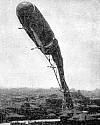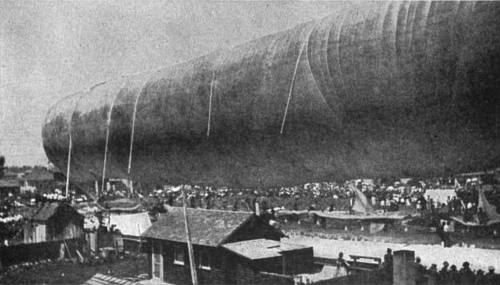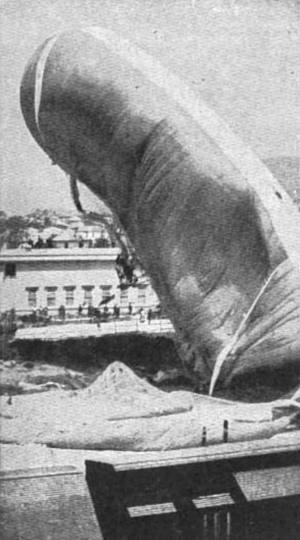
|
Morrell Airship Collapse - 23 May 1908
First major U.S. airship disaster.
|
Falling With a Wrecked Airship
One of the Passengers Relates His Sensations
from Popular Mechanics (1908)

Just Before the Ascent: Only a Little More Than Half the Ship is Shown
[p.449] Captain Penfold, the Australian aeronaut who was a stowaway on the Morrell airship when it met with the disaster described in the July issue of this magazine, and who had both legs broken near the ankles as a souvenir of its collapse, has probably made as many balloon ascensions as any aeronaut in the country. During the time the United States “Battle Fleet” was lying off the Golden Gate, and San Francisco was convulsed with the enthusiasm attending its welcome, Captain Penfold made a number of night ascensions in cooperation with the fleet. The idea was to determine if a balloon or airship could get near enough to such a fleet to do serious damage without being discovered, or to land men upon or close beside the ships. The hour at which the aeronaut was to ascend each night was kept from the fleet, but every ship had instructions to watch for him with the searchlights. On two of the nights the searchlights caught him as he was dropping with the parachute, but on one night he dropped into the midst of them without being caught and almost drowned before he was located and rescued from the water.

Rear Portion Held Some Gas
This was, of course, before the accident to the Morrell airship. He had been an interested watcher of the work of preparing the huge dirigible balloon for the flight on May 23, and had made preparations to be one of the party. On the day of the flight J. A. Morrell, the inventor, tried to dissuade him from going, but when the ship left the ground he was on board. Later, in the Roosevelt hospital at Berkeley, he wrote us a letter describing how he felt when the airship collapsed.
“I have made many balloon ascensions to great heights,” said Captain Penfold, “and have fallen distances of four and five hundred feet at terrific speed before my parachute opened, so the sensation of falling was not a new one to me. But I always knew the parachute would open and that it would gradually check my fall, dropping me gently when earth was again reached. Were you ever in a position in which you were badly in need of something you usually had with you, but for once in your life was without? If you have ever had such an experience you know just what I was feeling when the gas bag burst above my head and we pitched downward.
“I was near the center of the airship and Mr. Morrell was standing a few feet distant. The ship had risen gracefully and presented a magnificent sight. Not a breath of wind was stirring as we rose to an altitude of 300 ft. While the cheers of thousands came floating up to us the rope near the center of the huge gas bag cut through the covering, and it collapsed. I shot a quick glance at Inventor Morrell and instinctively clutched at my parachute ropes. My hands touched nothing familiar. I was in an airship, not in my balloon. I missed the parachute, missed it horribly, and yet, if I had had it, it would not have availed me, as we were too close to the earth for its use. You see, in a balloon of the kind used in spectacular ascensions the only way to get back to earth is to fall, and we prepare for it, but in an airship there is no way to fall but hard.
“The fall was not rapid, or at least, not to me, and the accident might easily have had far more fatal results. The rear portion, as shown in one of the illustrations, held some gas, and the crew near that end escaped practically unhurt. We, in the center and forward end, however, came down hard enough to realize we had reached solid earth again, and I for one, was not sorry after the first first shock was over.”
 Huge Dirigible Balloon Collapses
- previous month's article
on Morrell's Airship Collapse in Popular
Mechanics (Jul 1908).
Huge Dirigible Balloon Collapses
- previous month's article
on Morrell's Airship Collapse in Popular
Mechanics (Jul 1908). Old Fabric Caused Airship Wreck
- following month's article
on Morrell's Airship Collapse in Popular
Mechanics (Sep 1908).
Old Fabric Caused Airship Wreck
- following month's article
on Morrell's Airship Collapse in Popular
Mechanics (Sep 1908). 23
May - short
biography, births, deaths
and events on date of Morrell's Airship Collapse.
23
May - short
biography, births, deaths
and events on date of Morrell's Airship Collapse. Booklist
for Airships History
Booklist
for Airships History




